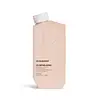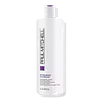What's inside
What's inside
 Key Ingredients
Key Ingredients

No key ingredients
 Benefits
Benefits

 Concerns
Concerns

 Ingredients Side-by-side
Ingredients Side-by-side

Water
Skin ConditioningSodium Methyl 2-Sulfolaurate
CleansingSodium Cocoyl Isethionate
CleansingCocamidopropyl Hydroxysultaine
CleansingDisodium 2-Sulfolaurate
CleansingPEG-2 Cocamide
EmulsifyingCocamidopropyl Betaine
CleansingPEG-150 Distearate
EmulsifyingPanthenol
Skin ConditioningZingiber Officinale Root Extract
MaskingUrtica Dioica Extract
AstringentOleanolic Acid
Skin ConditioningAesculus Hippocastanum Seed Extract
Skin ConditioningEuterpe Oleracea Fruit Extract
Bambusa Vulgaris Leaf/Stem Extract
HumectantOryza Sativa Bran Oil
EmollientSilk Amino Acids
HumectantRice Amino Acids
Skin ConditioningKeratin Amino Acids
Skin ConditioningAloe Barbadensis Leaf Juice
Skin ConditioningCreatine
Skin ConditioningApigenin
AntioxidantBiotinoyl Tripeptide-1
Lactic Acid
BufferingZinc Picolinate
SoothingGlycerin
HumectantIsopropyl Alcohol
SolventButylene Glycol
HumectantPropanediol
SolventButyloctanol
HumectantDicetyldimonium Chloride
EmulsifyingSilicone Quaternium-16
Skin ConditioningPPG-26-Buteth-26
Skin ConditioningGlycol Distearate
EmollientGuar Hydroxypropyltrimonium Chloride
Skin ConditioningUndeceth-11
EmollientPEG-120 Methyl Glucose Trioleate
CleansingSteareth-4
EmulsifyingPEG-40 Hydrogenated Castor Oil
EmulsifyingUndeceth-5
EmulsifyingPolyquaternium-7
Polyquaternium-10
Disodium EDTA
Trisodium Hedta
Phenoxyethanol
PreservativeEthylhexylglycerin
Skin ConditioningChlorphenesin
AntimicrobialSorbic Acid
PreservativeBenzoic Acid
MaskingPotassium Sorbate
PreservativeSodium Benzoate
MaskingLactobacillus Ferment
Skin ConditioningLeuconostoc/Radish Root Ferment Filtrate
AntimicrobialIodopropynyl Butylcarbamate
PreservativeCitric Acid
BufferingParfum
MaskingBenzyl Benzoate
AntimicrobialBenzyl Salicylate
PerfumingHydroxycitronellal
PerfumingWater, Sodium Methyl 2-Sulfolaurate, Sodium Cocoyl Isethionate, Cocamidopropyl Hydroxysultaine, Disodium 2-Sulfolaurate, PEG-2 Cocamide, Cocamidopropyl Betaine, PEG-150 Distearate, Panthenol, Zingiber Officinale Root Extract, Urtica Dioica Extract, Oleanolic Acid, Aesculus Hippocastanum Seed Extract, Euterpe Oleracea Fruit Extract, Bambusa Vulgaris Leaf/Stem Extract, Oryza Sativa Bran Oil, Silk Amino Acids, Rice Amino Acids, Keratin Amino Acids, Aloe Barbadensis Leaf Juice, Creatine, Apigenin, Biotinoyl Tripeptide-1, Lactic Acid, Zinc Picolinate, Glycerin, Isopropyl Alcohol, Butylene Glycol, Propanediol, Butyloctanol, Dicetyldimonium Chloride, Silicone Quaternium-16, PPG-26-Buteth-26, Glycol Distearate, Guar Hydroxypropyltrimonium Chloride, Undeceth-11, PEG-120 Methyl Glucose Trioleate, Steareth-4, PEG-40 Hydrogenated Castor Oil, Undeceth-5, Polyquaternium-7, Polyquaternium-10, Disodium EDTA, Trisodium Hedta, Phenoxyethanol, Ethylhexylglycerin, Chlorphenesin, Sorbic Acid, Benzoic Acid, Potassium Sorbate, Sodium Benzoate, Lactobacillus Ferment, Leuconostoc/Radish Root Ferment Filtrate, Iodopropynyl Butylcarbamate, Citric Acid, Parfum, Benzyl Benzoate, Benzyl Salicylate, Hydroxycitronellal
Water
Skin ConditioningCetyl Alcohol
EmollientDidecyldimonium Chloride
EmulsifyingPolyquaternium-37
Panthenol
Skin ConditioningHedychium Coronarium Flower/Leaf/Stem Extract
Skin ConditioningRosmarinus Officinalis Leaf Extract
AntimicrobialAnthemis Nobilis Flower Extract
MaskingAloe Barbadensis Leaf Extract
EmollientSimmondsia Chinensis Leaf Extract
HumectantAlgae Extract
EmollientWheat Amino Acids
Skin ConditioningHydrolyzed Wheat Protein
Skin ConditioningHydrolyzed Wheat Starch
Skin ConditioningHydrolyzed Wheat Protein Pg-Propyl Silanetriol
Skin ConditioningCocodimonium Hydroxypropyl Hydrolyzed Rice Protein
Skin ConditioningCetrimonium Chloride
AntimicrobialIsopropyl Alcohol
SolventPropylene Glycol Dicaprylate/Dicaprate
EmollientPPG-1 Trideceth-6
Skin ConditioningMagnesium Nitrate
Bisamino PEG/PPG-41/3 Aminoethyl Pg-Propyl Dimethicone
Methylchloroisothiazolinone
PreservativeMagnesium Chloride
Potassium Sorbate
PreservativePhenoxyethanol
PreservativePEG-12 Dimethicone
Skin ConditioningMethylisothiazolinone
PreservativeParfum
MaskingBenzyl Benzoate
AntimicrobialBenzyl Alcohol
PerfumingSodium Benzoate
MaskingWater, Cetyl Alcohol, Didecyldimonium Chloride, Polyquaternium-37, Panthenol, Hedychium Coronarium Flower/Leaf/Stem Extract, Rosmarinus Officinalis Leaf Extract, Anthemis Nobilis Flower Extract, Aloe Barbadensis Leaf Extract, Simmondsia Chinensis Leaf Extract, Algae Extract, Wheat Amino Acids, Hydrolyzed Wheat Protein, Hydrolyzed Wheat Starch, Hydrolyzed Wheat Protein Pg-Propyl Silanetriol, Cocodimonium Hydroxypropyl Hydrolyzed Rice Protein, Cetrimonium Chloride, Isopropyl Alcohol, Propylene Glycol Dicaprylate/Dicaprate, PPG-1 Trideceth-6, Magnesium Nitrate, Bisamino PEG/PPG-41/3 Aminoethyl Pg-Propyl Dimethicone, Methylchloroisothiazolinone, Magnesium Chloride, Potassium Sorbate, Phenoxyethanol, PEG-12 Dimethicone, Methylisothiazolinone, Parfum, Benzyl Benzoate, Benzyl Alcohol, Sodium Benzoate
Ingredients Explained
These ingredients are found in both products.
Ingredients higher up in an ingredient list are typically present in a larger amount.
Benzyl Benzoate is usually created from the condensation of benzoic acid and benzyl alcohol. It is used as a preservative, solvent, and has a floral/balsamic scent in large amounts.
As a preservative, Benzyl Benzoate works against bacteria and fungus. It is often used to treat scabies and lice in medicine.
Solvents are used to keep ingredients together in a product. They can help dissolve ingredients to stable bases or help evenly distribute ingredients throughout the product.
Due to its fragrance, Benzyl Benzoate can be sensitizing and may cause contact dermatitis. It is a known EU allergen. We recommend speaking with a professional if you have any concerns.
Benzyl Benzoate can be naturally found in cranberries and peaches.
Learn more about Benzyl BenzoateIsopropyl Alcohol is more commonly known as rubbing alcohol. It is most commonly used as a solvent, meaning it helps other ingredients dissolve.
This ingredient is an astringent alcohol. Astringent alcohols may also irritate skin as they high amounts may strip away your skin's natural oils.
Other types of astringent alcohols include:
According to the National Rosacea Society based in the US, you should be mindful of products with these alcohols in the top half of ingredients.
Any type of sanitizing product will have high amounts of alcohol to help kill bacteria and viruses.
Learn more about Isopropyl AlcoholPanthenol is a common ingredient that helps hydrate and soothe the skin. It is found naturally in our skin and hair.
There are two forms of panthenol: D and L.
D-panthenol is also known as dexpanthenol. Most cosmetics use dexpanthenol or a mixture of D and L-panthenol.
Panthenol is famous due to its ability to go deeper into the skin's layers. Using this ingredient has numerous pros (and no cons):
Like hyaluronic acid, panthenol is a humectant. Humectants are able to bind and hold large amounts of water to keep skin hydrated.
This ingredient works well for wound healing. It works by increasing tissue in the wound and helps close open wounds.
Once oxidized, panthenol converts to pantothenic acid. Panthothenic acid is found in all living cells.
This ingredient is also referred to as pro-vitamin B5.
Learn more about PanthenolParfum is a catch-all term for an ingredient or more that is used to give a scent to products.
Also called "fragrance", this ingredient can be a blend of hundreds of chemicals or plant oils. This means every product with "fragrance" or "parfum" in the ingredients list is a different mixture.
For instance, Habanolide is a proprietary trade name for a specific aroma chemical. When used as a fragrance ingredient in cosmetics, most aroma chemicals fall under the broad labeling category of “FRAGRANCE” or “PARFUM” according to EU and US regulations.
The term 'parfum' or 'fragrance' is not regulated in many countries. In many cases, it is up to the brand to define this term.
For instance, many brands choose to label themselves as "fragrance-free" because they are not using synthetic fragrances. However, their products may still contain ingredients such as essential oils that are considered a fragrance by INCI standards.
One example is Calendula flower extract. Calendula is an essential oil that still imparts a scent or 'fragrance'.
Depending on the blend, the ingredients in the mixture can cause allergies and sensitivities on the skin. Some ingredients that are known EU allergens include linalool and citronellol.
Parfum can also be used to mask or cover an unpleasant scent.
The bottom line is: not all fragrances/parfum/ingredients are created equally. If you are worried about fragrances, we recommend taking a closer look at an ingredient. And of course, we always recommend speaking with a professional.
Learn more about ParfumPhenoxyethanol is a preservative that has germicide, antimicrobial, and aromatic properties. Studies show that phenoxyethanol can prevent microbial growth. By itself, it has a scent that is similar to that of a rose.
It's often used in formulations along with Caprylyl Glycol to preserve the shelf life of products.
Potassium Sorbate is a preservative used to prevent yeast and mold in products. It is commonly found in both cosmetic and food products.
This ingredient comes from potassium salt derived from sorbic acid. Sorbic acid is a natural antibiotic and effective against fungus.
Both potassium sorbate and sorbic acid can be found in baked goods, cheeses, dried meats, dried fruit, ice cream, pickles, wine, yogurt, and more.
You'll often find this ingredient used with other preservatives.
Learn more about Potassium SorbateSodium Benzoate is a preservative. It's used in both cosmetic and food products to inhibit the growth of mold and bacteria. It is typically produced synthetically.
Both the US FDA and EU Health Committee have approved the use of sodium benzoate. In the US, levels of 0.1% (of the total product) are allowed.
Sodium benzoate works as a preservative by inhibiting the growth of bacteria inside of cells. It prevents the cell from fermenting a type of sugar using an enzyme called phosphofructokinase.
It is the salt of benzoic acid. Foods containing sodium benzoate include soda, salad dressings, condiments, fruit juices, wines, and snack foods.
Studies for using ascorbic acid and sodium benzoate in cosmetics are lacking, especially in skincare routines with multiple steps.
We always recommend speaking with a professional, such as a dermatologist, if you have any concerns.
Learn more about Sodium BenzoateWater. It's the most common cosmetic ingredient of all. You'll usually see it at the top of ingredient lists, meaning that it makes up the largest part of the product.
So why is it so popular? Water most often acts as a solvent - this means that it helps dissolve other ingredients into the formulation.
You'll also recognize water as that liquid we all need to stay alive. If you see this, drink a glass of water. Stay hydrated!
Learn more about Water